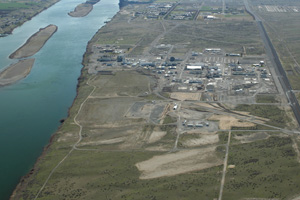Subsurface microorganisms play an important role in transforming contaminants. Microbial reactions can modify contaminant solubility, result in the precipitation or dissolution of mineral phases, consume electron donors, and reduce electron acceptors (and thereby alter the chemical and biogeochemical reactivity of microsites). Such transformations could be highly significant to long-term stewardship of contaminatd subsurface sediments.

The 300 Area of the Hanford Site near Richland, Washington.
For this project, JGI will sequence 16S rRNA from subsurface sediment sampled from a uranium-contaminated site in the 300 Area of the Hanford Site (used for plutonium production from 1943 to 1989). The sequences will yield a census of bacteria and archaea present in the subsurface, aiding researchers in determining the composition and activity of subsurface microbial communities in microenvironments and across transition zones. Microenvironments are small domains within larger ones that exert a disproportionate influence on subsurface contaminant migration. Transition zones are field-scale features where chemical, physical, or microbiologic properties change dramatically over distances less than one meter. As a result, important chemical species such as molecular oxygen (or other potential electron acceptors) and organic carbon have steep transport-controlled gradients in these regions that dramatically impact subsurface contaminant reactivity.
This work is one component of integrated, multidisciplinary research effortss supported by DOE-BER’s Environmental Remediation Sciences Program (ERSP) at Pacific Northwest National Laboratory to examine how geochemical and biogeochemical processes that operate at different spatial scales affect the fate and transport of radionuclides and other contaminants in the subsurface at DOE’s Hanford Site. The 300 Area subsurface environment, where uranium is the primary contaminant of concern, represents a valuable natural laboratory where hydrologic, mass transfer, and biogeochemical processes controlling contaminant fate and transport can be investigated across a span of biogeochemical environments—the vadose zone (earth above groundwater), aquifer, and hyporheic zone (interface between aquifer and river).
Principal Investigators: Allan Konopka and Jim Fredrickson (Pacific Northwest Natl. Lab.)
Program: CSP 2009